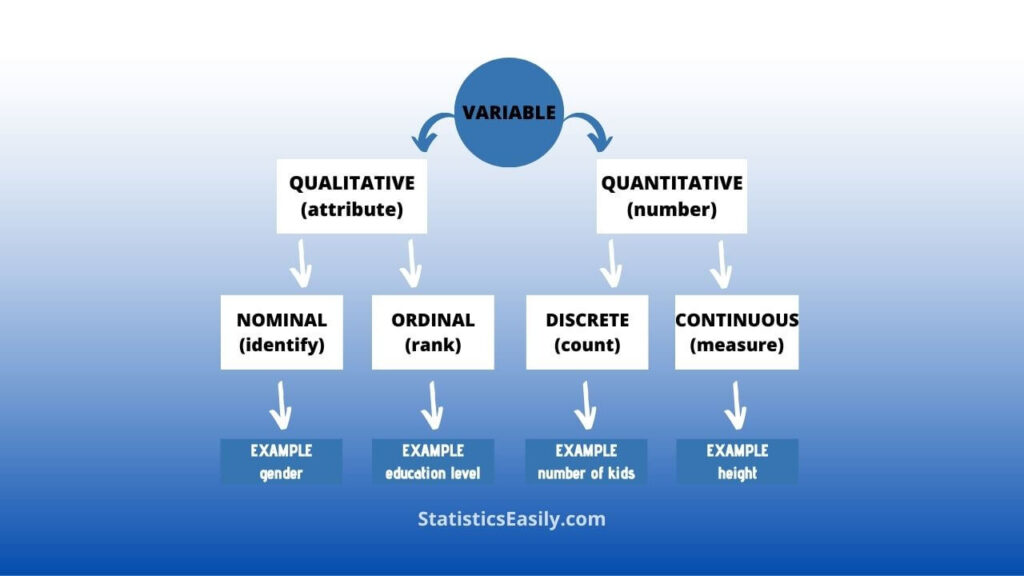What Makes a Variable Qualitative or Quantitative?
Qualitative vs Quantitative: A variable is qualitative if it represents non-numeric or categorical data like colors or satisfaction levels. It’s quantitative if it contains numeric data representing quantities, like height or number of students, allowing for more statistical operations.
Understanding Variables in Statistics
Variables are the cornerstone of statistics, providing the critical data researchers analyze. These variables serve as identifiers of specific characteristics or properties that we measure or observe, lending themselves to our ability to discern patterns, formulate conclusions, and forecast future trends. Intrinsically, variables are not static; they change and adapt based on various circumstances.
Statisticians categorize variables into two primary types: qualitative vs quantitative. This classification system is grounded in the type of data the variables contain. Understanding the difference between qualitative and quantitative variables is more than just a matter of terminology. It fundamentally shapes how we interpret data and can drastically influence our conclusions. Thus, a sound grasp of these concepts is crucial to effectively interpret and utilize statistical data.
Further, the choice of variables also shapes the statistical methods and techniques we can use in data analysis. For instance, specific tests are used only with qualitative data, while others are designed exclusively for quantitative data. In short, our entire statistical approach can be dictated by the nature of the variables we work with.
Highlights
- Qualitative variables represent non-numeric categories or groups.
- Quantitative variables express actual numerical quantities, allowing more mathematical operations.
- Nominal variables are qualitative and unordered, like car colors.
- Ordinal variables are qualitative and possess a clear hierarchy, such as customer satisfaction levels.
- Discrete variables, a type of quantitative variable, represent countable data like the number of students.
- Continuous variables, another quantitative variable, signify measurable data like human height.
Ad Title
Ad description. Lorem ipsum dolor sit amet, consectetur adipiscing elit.
Defining and Giving Examples of Qualitative Variables
Qualitative variables, often referred to as categorical variables, embody characteristics that can be categorized into different groups. Their essence lies in representing distinct categories or classes rather than indicating a measurable quantity. Qualitative data is often non-numeric, expressing attributes or qualities inherent in a dataset or group of subjects. Qualitative variables are further divided into nominal and ordinal variables based on the order or hierarchy within the categories.
Nominal variables are characterized by data that can be divided into multiple categories without particular order or priority. An example could be the color of a car. Cars can come in various colors — blue, red, green, etc. These categories are mutually exclusive and don’t possess an inherent order (red isn’t “greater” than blue, for example).
Conversely, ordinal variables are still categorical but entail an explicit order or rank. In other words, the categories have a particular sequence or hierarchy. For example, if we were to evaluate customer satisfaction, the categories could be ‘unsatisfied,’ ‘neutral,’ and ‘satisfied.’ Here, the classes are distinct and have a natural order, as ‘satisfied’ is a higher ranking than ‘unsatisfied.’
Defining and Giving Examples of Quantitative Variables
Quantitative variables, as the name implies, are intrinsically numeric. They represent quantities — data that we can measure or count, representing a numerical value. They provide measurable information, allowing for a more rigorous and precise data evaluation. Depending on whether the data they hold can be counted or measured with precision, quantitative variables can be classified as discrete or continuous variables.
Discrete variables represent countable data. They can only take specific values and not others. An example of a discrete variable would be the number of students in a class. You can have 30 students or 31 students, but not 30.5 students.
Continuous variables, however, represent measurements and can take on any value within a specific range. For instance, a person’s height could be any value within the possible range of human heights. Continuous variables can be measured and broken down to an infinite degree (within the limits of our measurement precision), making them ideal for representing data with a broad spectrum of possible values.
Differences Between Qualitative vs Quantitative Variables
Drawing a clear line between qualitative vs quantitative variables is essential to statistical data analysis. The crux of their differentiation hinges upon their data type: if a variable represents numerical data, it’s quantitative; if non-numeric or categorical, it’s qualitative. This simple yet impactful distinction profoundly influences the statistical techniques we can employ for analysis, from how we visualize the data to the inferential statistics we can perform.

Qualitative vs Quantitative Variables in Research
Using qualitative or quantitative variables in research hinges on the nature of the data needed to effectively answer the research questions. Both offer distinct perspectives and can reveal different layers of information, thus influencing the depth and direction of research findings.
Qualitative variables shine when the research demands the capturing of non-numeric data such as opinions, perceptions, feelings, or any other subjective parameters. They’re paramount for exploratory analysis, which aims to delve into human behavior, experiences, and motivations. For instance, qualitative variables help uncover the reasons behind certain behaviors in social sciences or market research, delivering more profound and richer insights.
Conversely, quantitative variables excel at delivering numerical data that can be statistically examined to disclose patterns, correlations, and trends. They’re instrumental in fields where precision is paramount, such as scientific research, economics, healthcare, or any area where quantifiable measurements drive insights. With their numerical nature, quantitative variables can be used to build mathematical models, test hypotheses, and provide a robust analytical framework for decision-making.
Common Mistakes and Misunderstandings in Variable Classification
Classifying variables can be complicated, and mistakes can easily creep into the process. One prevalent misstep is the assumption that numbers always infer quantitative variables. However, numerical values can occasionally be qualitative when they serve as codes or labels rather than meaningful quantities. For instance, while composed of numbers, a zip code is essentially a nominal variable representing a geographic category, not a quantity.
Another widespread misunderstanding is underestimating the value of qualitative data, often seen as less rigorous or informative than quantitative data. This perception is misleading. While qualitative data may not lend itself to the same statistical scrutiny as quantitative data, it offers unique insights into the quality, context, and complexity of the subject under study. Moreover, qualitative and quantitative data often complement each other, with qualitative data offering depth and nuance and quantitative data providing structure and breadth. Recognizing this, researchers often use both types in tandem for a comprehensive analysis.
Understanding the difference between qualitative and quantitative variables is critical to robust and accurate data analysis. Researchers need to carefully consider these classifications and their implications and potential pitfalls to ensure their results are valid, reliable, and insightful.
Ad Title
Ad description. Lorem ipsum dolor sit amet, consectetur adipiscing elit.
Recommended Articles
If you found this article enlightening, we invite you to delve deeper into similar topics on our blog. Expand your knowledge and become an expert in data analysis and statistics. Start exploring now!
- Graph Selection Guide (Story)
- Applied Statistics: Data Analysis
- Create Great Graphs Easily (+Bonus)
- How To Select The Appropriate Graph?
- The Role of Dependent Variables (Story)
- In Science, What is a Dependent Variable?
- Categorical Variable – an overview (External Link)
Frequently Asked Questions (FAQs)
Variables in statistics represent the characteristics we measure or observe. They form the basis of any data analysis and can be qualitative or quantitative.
Qualitative or categorical variables represent non-numeric or categorical data such as colors, brands, or satisfaction levels.
Quantitative variables represent numerical data that signify quantities, allowing for more mathematical operations. Examples include height, weight, or number of items.
Nominal and ordinal variables are types of qualitative variables. Nominal variables are unordered categories like car colors, while ordinal variables have a clear hierarchy, such as customer satisfaction levels.
Discrete and continuous variables are types of quantitative variables. Discrete variables represent countable data, while continuous variables signify any value within a defined range.
Yes, numerical values can be qualitative when they serve as codes or labels, like zip codes, representing geographic categories rather than meaningful quantities.
Both qualitative and quantitative variables provide unique insights. Qualitative variables offer depth and context, while quantitative variables provide structure and allow for rigorous analysis.
Qualitative variables are crucial when researchers need to capture non-numeric data, such as perceptions, opinions, or feelings. They often reveal more profound insights into human behavior and experiences.
Quantitative variables provide numerical data that can be statistically analyzed to reveal patterns, trends, and correlations. They are vital in fields where precise measurement is essential.
Common mistakes include assuming that all numeric data is quantitative and underestimating the value of qualitative data. Both types of data are equally important and often used in conjunction.








